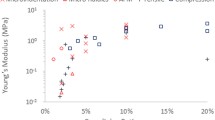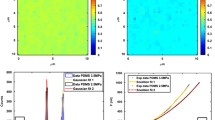Abstract
Indentation tests utilizing the load (P)-displacement (δ) data have been common for obtaining bulk moduli (E) of hydrated materials, including biological specimens and hydrogels. While experimentally simple to perform, the data analysis can sometimes be complicated, especially when adhesion between the indenter and sample occurs. The adhesion issue for nano/microindentation on hydrated materials has been addressed in several studies, but hardly any studies have reported the involvement of adhesion in analyzing mesoscale (0.1–1 mm) P-δ data. In this study, we evaluated three methods for analyzing experimental P-δ data acquired from mesoscale indentations on hydrated materials to obtain their E values. They were the classical Hertz model, a modified Hertz approach with P and δ values corrected using Hertz relations, and a modified Hertz approach with the correction of contact radius (a) by including the work of adhesion, W, between the indenter and the sample. The experimental P, a, and δ data were simultaneously collected using transparent gelatin gels, and these P-δ and P-a data were used to verify the adequacy of the three analysis methods. In particular, the E values from these methods were checked against the values obtained using the Johnson-Kendall-Roberts model and the P-a data. Accurate moduli resulted only when W was included in the analysis. The analysis with the inclusion of W was applied to obtain the E values of silicone and other model hydrogels, of which only the experimental P-δ data could be obtained, and their moduli were found to be close to the values reported.





Similar content being viewed by others
Data availability
The data sets supporting this manuscript have been uploaded as part of the Supplementary Material.
References
Chen, P.Y., Lin, A.Y.M., Lin, Y.S., Seki, Y., Stokes, A.G., Peyras, J., Olevsky, E.A., Meyers, M.A., McKittrick, J.: Structure and mechanical properties of selected biological materials. J. Mech. Behav. Biomed. Mater. 1, 208–226 (2008)
Zou, H., Wu, S., Shen, J.: Polymer/silica nanocomposites: preparation, characterization, properties, and applications. Chem. Rev. 108, 3893–3957 (2008)
Mitragotri, S., Lahann, J.: Physical approaches to biomaterial design. Nat. Mater. 8, 15–23 (2009)
Khatiwala, C.B., Peyton, S.R., Putnam, A.J.: Intrinsic mechanical properties of the extracellular matrix affect the behavior of pre-osteoblastic MC3T3-E1 cells. Am. J. Physiol. Cell Physiol. 290, 1640–1650 (2006)
Yeung, T., Georges, P.C., Flanagan, L.A., Marg, B., Ortiz, M., Funaki, M., Zahir, N., Ming, W., Weaver, V., Janmey, P.A.: Effects of substrate stiffness on cell morphology, cytoskeletal structure, and adhesion. Cell Motil. Cytoskeleton 60, 24–34 (2005)
Discher, D.E., Janmey, P., Wang, Y.-l: Tissue cells feel and respond to the stiffness of their substrate. Science. 310, 1139-1143 (2005)
Lo, C.-M., Wang, H.-B., Dembo, M., Wang, Y.-l: Cell movement is guided by the rigidity of the substrate. Biophys. J. 79, 144–152 (2000)
Engler, A.J., Sen, S., Sweeney, H.L., Discher, D.E.: Matrix elasticity directs stem cell lineage specification. Cell 126, 677–689 (2006)
Banerjee, A., Arha, M., Choudhary, S., Ashton, R.S., Bhatia, S.R., Schaffer, D.V., Kane, R.S.: The influence of hydrogel modulus on the proliferation and differentiation of encapsulated neural stem cells. Biomaterials 30, 4695–4699 (2009)
Eichhorn, S.J., Dufresne, A., Aranguren, M., Marcovich, N.E., Capadona, J.R., Rowan, S.J., Weder, C., Thielemans, W., Roman, M., Renneckar, S., Gindl, W., Veigel, S., Keckes, J., Yano, H., Abe, K., Nogi, M., Nakagaito, A.N., Mangalam, A., Simonsen, J., Benight, A.S., Bismarck, A., Berglund, L.A., Peijs, T.: Review: current international research into cellulose nanofibres and nanocomposites. J. Mater. Sci. 45, 1–33 (2010)
Lee, D., Rahman, M.M., Zhou, Y., Ryu, S.: Three-dimensional confocal microscopy indentation method for hydrogel elasticity measurement. Langmuir 31, 9684–9693 (2015)
Lai, Y., He, D., Hu, Y.: Indentation adhesion of hydrogels over a wide range of length and time scales. Extreme Mech. Lett. 31, 1–11 (2019)
Rubiano, A., Galitz, C., Simmons, C.S.: Mechanical characterization by mesoscale indentation: advantages and pitfalls for tissue and scaffolds. Tissue Eng. Part C-Me. 25, 619–629 (2019)
Rubiano, A., Simmons, C.S.: Mesoscale, cantilever-based indentation device for mechanical characterization of soft matter and biological tissue. bioRxiv. 758342 (2019).
Lai, Y., Hu, Y.: The relation between adhesion properties and network properties of hydrogels: a study based on an indentation adhesion method. Mech. Mater. 159, 103877 (2021)
Hu, Y., You, J.-O., Auguste, D.T., Suo, Z., Vlassak, J.J.: Indentation: a simple, nondestructive method for characterizing the mechanical and transport properties of pH-sensitive hydrogels. J. Mater. Res. 27, 152–160 (2012)
Kalcioglu, Z.I., Mahmoodian, R., Hu, Y., Suo, Z., Van Vliet, K.J.: From macro- to microscale poroelastic characterization of polymeric hydrogels via indentation. Soft Matter 8, 3393–3398 (2012)
Hu, Y., Zhao, X., Vlassak, J.J., Suo, Z.: Using indentation to characterize the poroelasticity of gels. Appl. Phys. Lett. 96, 121904 (2010)
Hengsberger, S., Enstroem, J., Peyrin, F., Zysset, P.: How is the indentation modulus of bone tissue related to its macroscopic elastic response? A validation study. J. Biomech. 36, 1503–1509 (2003)
Li, Q.S., Lee, G.Y.H., Ong, C.N., Lim, C.T.: AFM indentation study of breast cancer cells. Biochem. Biophys. Res. Commun. 374, 609–613 (2008)
Charras, G.T., Horton, M.A.: Single cell mechanotransduction and its modulation analyzed by atomic force microscope indentation. Biophys. J. 82, 2970–2981 (2002)
Johnson, K.L., Kendall, K., Roberts, A.D.: Surface energy and the contact of elastic solids. Proc. R. Soc. Lond., A Math. Phys. Sci. 324, 301–313 (1971)
Shull, K.R.: Contact mechanics and the adhesion of soft solids. Mater. Sci. Eng. R Rep. 36, 1–45 (2002)
Shi, X., Zhao, Y.P.: Comparison of various adhesion contact theories and the influence of dimensionless load parameter. J. Adhes. Sci. Technol. 18, 55–68 (2004)
Long, R., Hall, M.S., Wu, M., Hui, C.-Y.: Effects of gel thickness on microscopic indentation measurements of gel modulus. Biophys. J. 101, 643–650 (2011)
Frey, M.T., Engler, A., Discher, D.E., Lee, J., Wang, Y.L.: Microscopic methods for measuring the elasticity of gel substrates for cell culture: microspheres, microindenters, and atomic force microscopy. Methods Cell Biol., 83, 47-65, (2007)
Sicard, D., Fredenburgh, L.E., Tschumperlin, D.J.: Measured pulmonary arterial tissue stiffness is highly sensitive to AFM indenter dimensions. J. Mech. Behav. Biomed. 74, 118–127 (2017)
Lee, D., Zhang, H., Ryu, S.: Elastic modulus measurement of hydrogels. in: M.I.H. Mondal (Ed.) Cellulose-Based Superabsorbent Hydrogels. Polymers and Polymeric Composites: A Reference Series., Springer, Cham, 2018, pp. 1–21.
Garcia, M., Schulze, K.D., O’Bryan, C.S., Bhattacharjee, T., Sawyer, W.G., Angelini, T.E.: Eliminating the surface location from soft matter contact mechanics measurements. Tribol. – Mater. Surf. Interfaces. 11, 1–6 (2017)
Efremov, Y.M., Bagrov, D.V., Kirpichnikov, M.P., Shaitan, K.V.: Application of the Johnson–Kendall–Roberts model in AFM-based mechanical measurements on cells and gel. Colloids Surf. B. Biointerfaces. 134, 131–139 (2015)
Lin, D.C., Horkay, F.: Nanomechanics of polymer gels and biological tissues: a critical review of analytical approaches in the Hertzian regime and beyond. Soft Matter 4, 669–682 (2008)
Taokaew, S., Phisalaphong, M., Newby, B.M.Z.: Modification of bacterial cellulose with organosilanes to improve attachment and spreading of human fibroblasts. Cellulose 22, 2311–2324 (2015)
Chan, E.P., Hu, Y., Johnson, P.M., Suo, Z., Stafford, C.M.: Spherical indentation testing of poroelastic relaxations in thin hydrogel layers. Soft Matter 8, 1492–1498 (2012)
Hu, Y., Chan, E.P., Vlassak, J.J., Suo, Z.: Poroelastic relaxation indentation of thin layers of gels. J. Appl. Phys. 110, 086103 (2011)
Wang, M., Liu, S., Xu, Z., Qu, K., Li, M., Chen, X., Xue, Q., Genin, G.M., Lu, T.J., Xu, F.: Characterizing poroelasticity of biological tissues by spherical indentation: an improved theory for large relaxation. J. Mech. Phys. Solids. 138, 103920 (2020)
Mel’nichenko, Y.B., Klepko, V.V., Shilov, V.V.: Self-diffusion of water in gelatin gels: 1. Macroscopic measurements by tracer technique. Polymer. 34, 1019–1023 (1993)
Hu, Y., Suo, Z.: Viscoelasticity and poroelasticity in elastomeric gels. Acta Mech. Solida Sin. 25, 441–458 (2012)
Fowkes, F.M.: Attractive forces at interfaces. Ind. Eng. Chem. 56, 40–52 (1964)
Loskofsky, C., Song, F., Zhang Newby, B.M.: Underwater adhesion measurements using the JKR technique. J. Adhes. 82, 713–730 (2006)
Mata, A., Fleischman, A.J., Roy, S.: Characterization of polydimethylsiloxane (PDMS) properties for biomedical micro/nanosystems. Biomed. Microdevices. 7, 281–293 (2005)
Lee, J.N., Jiang, X., Ryan, D., Whitesides, G.M.: Compatibility of mammalian cells on surfaces of poly(dimethylsiloxane). Langmuir 20, 11684–11691 (2004)
Ahearne, M., Yang, Y., El Haj, A.J., Then, K.Y., Liu, K.-K.: Characterizing the viscoelastic properties of thin hydrogel-based constructs for tissue engineering applications. J. R. Soc. Interface. 2, 455–463 (2005)
Dong, R., Jensen, T.W., Engberg, K., Nuzzo, R.G., Leckband, D.E.: Variably elastic hydrogel patterned via capillary action in microchannels. Langmuir 23, 1483–1488 (2007)
Stolz, M., Raiteri, R., Daniels, A.U., VanLandingham, M.R., Baschong, W., Aebi, U.: Dynamic elastic modulus of porcine articular cartilage determined at two different levels of tissue organization by indentation-type atomic force microscopy. Biophys. J. 86, 3269–3283 (2004)
Funding
The authors are grateful to the Royal Golden Jubilee Ph.D program from the Thailand Research Fund for the financial support to initiate this study and Nagaoka University of Technology.
Author information
Authors and Affiliations
Corresponding author
Additional information
Publisher's note
Springer Nature remains neutral with regard to jurisdictional claims in published maps and institutional affiliations.
Siriporn Taokaew is the first author.
Supplementary Information
Below is the link to the electronic supplementary material.
Rights and permissions
About this article
Cite this article
Taokaew, S., Pineault, H., Covington, K. et al. The role of adhesion on mesoscale indentation for determining moduli of hydrated materials. Mech Soft Mater 4, 1 (2022). https://doi.org/10.1007/s42558-021-00039-6
Received:
Accepted:
Published:
DOI: https://doi.org/10.1007/s42558-021-00039-6




